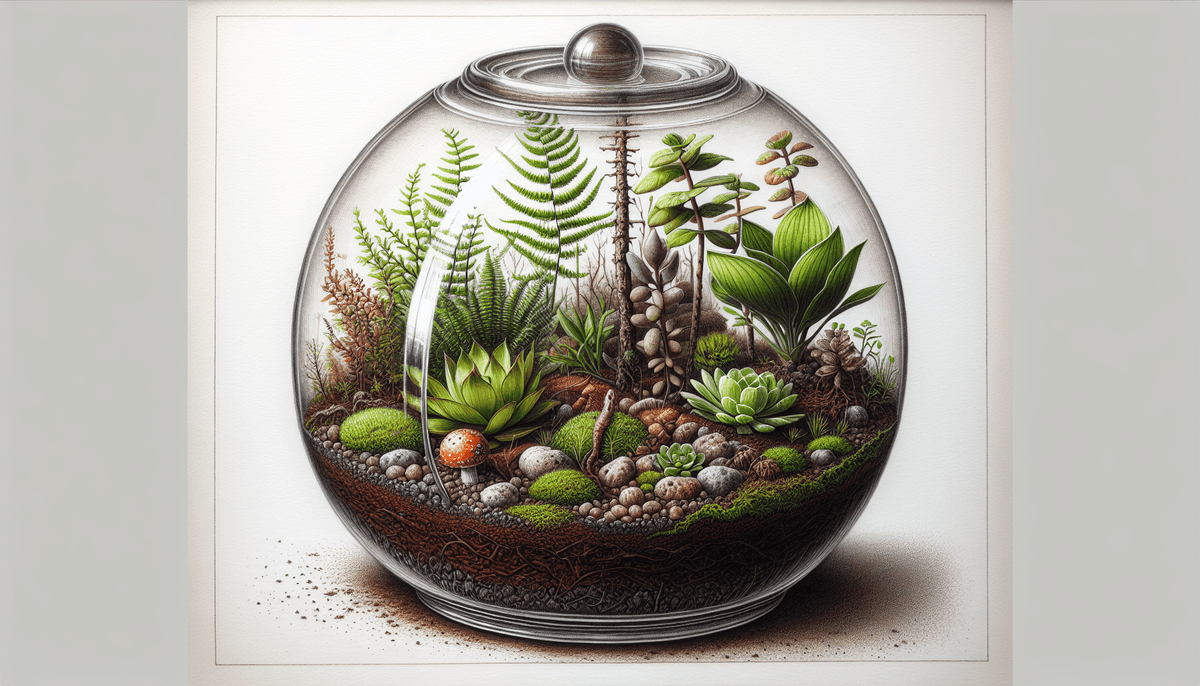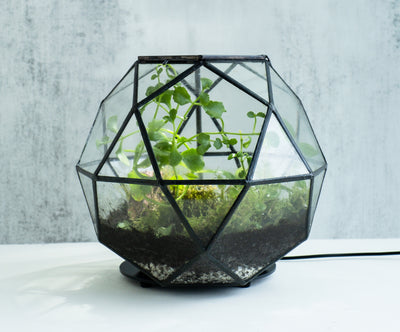How are terrariums self-sustaining? These miniature ecosystems thrive by cycling nutrients, water, and gases within a sealed container. Plants in terrariums perform photosynthesis, converting light into energy and oxygen, which supports their continual growth and sustenance. With the right balance of elements, a terrarium can maintain itself with little to no extra care.
Key Takeaways
-
Closed terrariums are self-sustaining ecosystems that rely on natural cycles like photosynthesis and water recycling to thrive without external resources.
-
Creating a successful terrarium involves careful layering of materials, choosing the right plants like ferns and mosses, and providing proper lighting to support growth.
-
Regular maintenance is essential, including monitoring moisture levels and removing dead plant material, to maintain a balanced environment and prevent common issues like mold and overwatering.
Understanding Self-Sustaining Ecosystems

At its core, a closed terrarium is a sealed ecosystem that mimics the natural world in a miniature, enclosed form. It’s a fascinating showcase of how a diverse ecosystem can thrive without any external resources, much like the Earth itself. In ideal conditions, these miniature ecosystems can sustain themselves for decades, such as David Latimer’s famous terrarium, which has thrived for over six decades with minimal intervention.
Closed terrariums replicate natural cycles, including rain and nutrient cycles, to sustain themselves. Within these glass containers, plants produce their own food through photosynthesis and recycle organic matter, maintaining a delicate balance of gases and nutrients. This continuous cycle of growth and decay within a sealed environment is what keeps the ecosystem alive and flourishing over time.
The beauty of a closed terrarium lies in its ability to demonstrate the principles of larger ecosystems on a smaller scale. Similar to our planet, a terrarium depends on photosynthesis and respiration to sustain life. This intricate dance of biotic factors within a controlled space offers us a glimpse into the marvels of nature’s self-sustaining capabilities.
Key Components of a Self-Sustaining Terrarium

Creating a self-sustaining terrarium requires careful selection and layering of materials to ensure a balanced environment. Start by selecting an appropriate container. A glass container with a lid is ideal as it allows light to penetrate while maintaining a sealed environment. The first layer at the bottom of the terrarium should consist of small pebbles or stones, which act as a drainage layer to prevent excess water from accumulating around the plant roots.
Next, a layer of activated charcoal is added to prevent the buildup of harmful bacteria and odors. This is followed by a layer of sphagnum moss or gauze to separate the drainage layer from the soil. The soil mix should be a high-quality tropical substrate, at least twice as thick as the pebble layer, to provide the necessary nutrients for plant growth. Adding organic matter like earthworm castings can further improve plant health.
Selecting the right plants is crucial for the success of a closed terrarium. Moist woodland and tropical plants are ideal as they thrive in the humid environment of a sealed container. Make sure the plants are healthy and free of dead or yellow leaves before adding them to your terrarium. Mosses act as natural humidity indicators and can add a lush green touch to your miniature ecosystem.
Finally, decorative items such as small figurines or stones can be added to personalize your terrarium. However, it’s essential to maintain a balance and not overcrowd the container, as each plant needs space to grow and access to light. Layering these components thoughtfully creates a stable, self-sustaining environment that thrives with minimal maintenance. Check our blog post on how to make a closed terrarium.
The Role of Photosynthesis in Terrariums
Photosynthesis serves as the cornerstone of life in a closed terrarium. Through this process, plants convert light energy into chemical energy, produce their food, and release oxygen, maintaining the ecosystem’s balance. Within the sealed environment, the plants utilize sunlight, water, and carbon dioxide to create sugars, supporting their growth and sustaining the miniature ecosystem.
The chlorophyll in plant leaves captures sunlight, which drives the photosynthetic process. During daylight hours, photosynthesis occurs, allowing all the plants to produce energy for their growth and release oxygen into the terrarium. This oxygen is then used by the plants and any microorganisms present for respiration, creating a continuous cycle of gas exchange that keeps the ecosystem in equilibrium.
Selecting suitable plants for photosynthesis is essential. Plants like ferns, mosses, and small vining plants, as well as multiple plants, are excellent choices as they thrive in the humid, low-light conditions of a closed terrarium. By selecting the right terrarium plants and ensuring they receive adequate light, you can maintain a healthy, self-sustaining ecosystem that mirrors the natural world on a smaller scale.
Water Cycle Within a Closed Terrarium

The water cycle in a closed terrarium showcases natural recycling. Water moves from the soil to the atmosphere through evaporation, then condenses on the glass walls of the container and drips back into the soil, creating a self-sustaining cycle. This continuous movement of water ensures that the plants inside the terrarium remain hydrated without the need for additional watering.
Condensation is a normal part of this process, indicating a properly functioning water cycle. However, too much moisture can lead to issues like mold growth. If you notice excessive condensation, simply remove the lid for a few hours to allow some of the moisture to escape. This helps maintain the ideal humidity levels for your terrarium plants.
A properly sealed terrarium creates a humid environment, which is beneficial for moisture-loving plants. The presence of moss can help indicate the humidity levels within the terrarium, as moss tends to thrive in wet conditions. Understanding and managing the water cycle ensures a healthy and balanced miniature ecosystem.
Importance of Proper Lighting

Adequate lighting is crucial for the health and growth of plants in a closed terrarium. While natural light is beneficial, placing your terrarium in direct sunlight can cause the temperature inside to rise rapidly, potentially harming the plants. Indirect light is the best option, as it provides enough illumination for photosynthesis without the risk of overheating.
To achieve the right balance, place your terrarium in a location where it receives plenty of indirect light. If natural light is insufficient, consider using LED grow lights to supplement the light needs of your plants. These lights can be adjusted to provide the optimal light conditions, ensuring that your terrarium plants receive the energy they need for growth.
Monitoring light exposure over time is also necessary. As the seasons change, the intensity and duration of natural light can vary, so be prepared to adjust your setup accordingly. Clear containers are ideal for closed terrariums as they allow maximum light penetration, supporting the photosynthetic process and maintaining a vibrant and healthy ecosystem.
Choosing the Best Plants for Closed Terrariums

Selecting the right plants is vital for creating a successful closed terrarium. Plants like ferns, mosses, and small vining plants are well-suited for the humid, low-light conditions of a sealed environment. These plants thrive in damp conditions and contribute to the overall health and balance of the terrarium.
Avoid using cacti and succulents in closed terrariums, as they prefer dry environments and are prone to rot in the high humidity of a sealed container. Instead, focus on plants that can tolerate and even benefit from the constant moisture. When purchasing plants, ensure they are healthy and free from pests or diseases to give your terrarium the best start.
Properly cultivating and maintaining moss is also essential, as it helps regulate humidity and adds a lush green aesthetic to your terrarium. Choosing the right plants and providing suitable conditions creates a vibrant, self-sustaining ecosystem that brings a touch of nature into your home. Check out our recommended terrarium plants
Maintaining Balance in a Closed Terrarium
Maintaining a closed terrarium requires regular monitoring and occasional adjustments to ensure a healthy balance. One key aspect is managing moisture levels. Condensation on the glass is normal, but excessive moisture can lead to problems. If you notice too much condensation, remove the lid for a day or place the terrarium in the sun with the lid off to reduce humidity.
Another crucial task is removing dead plant material and debris from the terrarium to prevent decay and maintain a healthy environment. Using long tweezers can help you reach into the terrarium without disturbing the plants too much. Regular maintenance like this ensures the long-term health and stability of your miniature ecosystem.
Balancing light, water, and plant health is crucial for a thriving terrarium. Paying attention to these factors and making small adjustments as needed helps maintain a beautiful, self-sustaining environment with minimal ongoing effort.
Common Issues and Solutions
Common issues can arise in a closed terrarium even with the best care.
Mold is a frequent problem, often caused by excessive moisture and poor air circulation.
To combat mold, you can:
-
Promptly remove any affected leaves.
-
Allow for air circulation by briefly removing the lid.
-
Replace some of the substrate with fresh material to help reduce mold spores.
Overwatering is another common issue, leading to waterlogged soil and root rot. If you notice excess water, drain it out and allow the soil to dry slightly before resealing the terrarium. Fungus gnats can also be a problem in terrariums. Allowing the soil to dry out and using yellow sticky traps can help manage these pests.
Addressing these common issues is key to maintaining a healthy terrarium. By following these solutions, you can ensure your miniature ecosystem remains vibrant and beautiful for years to come.
Summary
Creating and maintaining a self-sustaining terrarium is a rewarding endeavor that brings a piece of nature into your home. By understanding the essential components, the role of photosynthesis, and the importance of proper lighting and water cycles, you can create a thriving miniature ecosystem. Regular maintenance and addressing common issues will help keep your terrarium in balance, ensuring its longevity.
With this knowledge, you’re well-equipped to start your journey into the fascinating world of self-sustaining terrariums. Embrace the beauty and tranquility of these miniature ecosystems and enjoy the sense of accomplishment that comes with nurturing a thriving, self-contained environment.
Frequently Asked Questions
What are the best plants for a closed terrarium?
Ferns, mosses, and small vining plants are perfect for a closed terrarium because they love the humidity and low light. These options will help create a lush, thriving mini ecosystem!
How do I manage condensation in my terrarium?
To manage condensation in your terrarium, simply remove the lid for a few hours to let excess moisture escape and lower humidity levels. It's a quick fix to keep your plants happy!
Can I use succulents in my closed terrarium?
It's not a good idea to use succulents in closed terrariums since they thrive in dry conditions and can easily rot in the humidity of a sealed environment. Stick to moisture-loving plants for your closed terrarium instead!
How often should I water my terrarium?
You typically don’t need to water your terrarium often, as it creates its own water cycle that keeps plants hydrated. Just check the moisture level occasionally and water if the soil looks dry.
What should I do if I notice mold in my terrarium?
If you spot mold in your terrarium, quickly remove any affected leaves and allow for air circulation by taking off the lid for a bit. You might also want to swap out some of the substrate with fresh material to help cut down on mold spores.
Terrarium Starter Kits
As KraftStories, we provide variety of terrarium starter kits. Check out our terrarium kits.

